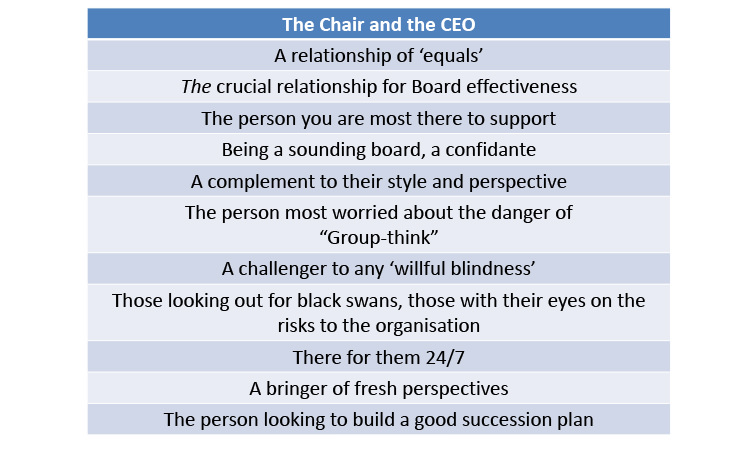“I think about this company 24/7!” That’s how it was. That’s how the founder and his team built a thriving company together. His genius built the company from scratch, but when he needed an outside perspective, when he needed a little extra insight and support, he came to us.
Strong, healthy, dynamic organisations need strong, healthy, dynamic relationships, especially between the CEO and the Chair. The relationship is crucial for the ongoing good governance and health of an organisation. And it’s true at all points in an organisation’s life-cycle, whether it’s the buzz and energy you get in the early stages of a start-up or the steady, established heights you experience in an organisation well into its maturity.
The organisation may require people with different experience in each of these scenarios but they both require a distinctive skill-set.

What the UK Institute of Directors says
The UK’s Institute of Directors Strategy Director, Bob Garratt, has a lot to say about what makes Boards effective, and his wisdom is worth quoting in full:
‘Strategy is seeing – seeing ahead, seeing behind, seeing above, seeing below, seeing beyond, seeing beside, and finally seeing through… It is the ability to make better, more comprehensive, more imaginative pictures about the past, present and future which helps differentiate an effective Board from its competitors’
Bob Garratt The Fish Rots from the Head
‘The fish rots from the head’ is, of course, a brilliant metaphor for the process that happens when the Board, or the relationship between the Chair and the CEO, is not working well and the organisation is in trouble.
You can purchase this important book here.
It just goes to show how very important it is to know exactly what makes a great chair, and The Harvard Business Review has some important insight to offer.
The characteristics of an effective Chair
INSEAD Professor of Organisational Studies, Stanislav Shekshnia, has recently published the results of an extensive survey he and his colleagues conducted.

INSEAD’s Corporate Governance Centre hosted the research. The project surveyed 200 Board Chairs from 31 countries, conducted 80 interviews with Chairs, and 60 interviews with Board members, shareholders, and CEOs. Drawing on companies from different national contexts and disparate ownership structures, they discerned a remarkable degree of agreement about what makes a good Chair, identifying eight important characteristics.
The characteristics of a good chair
Good chairs always manifest the following 8 important characteristics.
Support and being there
The most important characteristic of a Chair is acting as a guide on the side for the CEO. Good Chairs don’t immediately jump in with answers or try to call the shots. Good Chairs don’t try to take over. They’re there for their CEO 24/7, and that takes patience. Indeed, the researchers found that there were three core characteristics that all the best Chairs have:
Restraint – Good Chairs hold back, they don’t need the limelight, they don’t need to hog centre stage. Great Chairs repeatedly create settings for others to shine. When the researchers asked which Chair behaviours led to the most productive board sessions, they got answers like “being restrained”, “being non-domineering,” and “creating space for others.” Effective Chairs don’t shoot their mouths off, they listen, and they often speak very little. The interventions they make are always apt, strategic and timely. And they give great attention to people rather than concentrate on the best process.
Patience – Good Chairs know the value of waiting and understand the power of perspective. Great Chairs know when to help the CEO pause and reflect. Instead of dashing to make things happen quickly, they focus on getting the right things done well. They are often passionate about their organisations, and the work, but their passion is tempered by thoughtfulness and thoroughness.
Availability – 24/7 means 24/7. Although formal contracts often specify set hours and part-time involvement, the best Chairs were never ‘jobsworth’ about their commitment, but were always fully committed to the success of the business and their support of the CEO, putting in the necessary hours no matter what their employment contract agreed to.
Great chairs facilitate teaming, not team-building
Harvard Business School professor Amy Edmondson has developed a concept she calls ‘teaming’ to describe the process of gathering experts together to collaborate as a transitory group and solve problems they encounter for the first and only time. To enable teaming, the Chair has to move the focus from building elaborate protocols and obsessing about group norms and focus on structuring, sorting, and being systemic to facilitate collaboration.
IBM’s former head of Knowledge Management, Dave Snowden, has a useful way of characterising what he calls ‘knowledge spaces’ – you are either in what he calls ‘simple space’, ‘complicated space’, ‘complex space’ or ‘crisis space’.
Most Board work is in complex space, requiring people to function intuitively and flexibly, and apply constant curiosity about the impact of their decisions. Find out more here.
Use preparation to the full
Inexperienced Chairs often think the job is all about turning up and managing the dynamics in the boardroom on the day. Experienced ones, however, recognise that the meetings are the culmination of much collaboration and discussion beforehand.
A vital component of the Chair’s contribution is setting the agenda and putting together the supporting documentation. Being astute means that nothing gets to the Board that will waste its time, or distract it from its primary purpose as, in Bob Garratt’s words, the ‘business brain’ of the organisation. Only strategic matters, material things and those that are ripe for a decision should be taken to the Board.
Capitalise on the agility and flexibility of small groups
Small groups often do better work than big, cumbersome, formal groups. Mandating small sub-groups of a Board to get things done can be extremely effective. Smaller groups can drill right down into the detail, apply their expertise, or even second new talent to help them address core matters and resolve key issues pre-Board.
Stay detached
New Chairs are often eager to demonstrate added-value and prove themselves. They flex their muscles, insisting their knowledge and experience is what’s needed. Sadly, the harsh business reality is that such overt displays of ego are unhelpful, and can actually detract from the core purpose of the Chair’s job: to encourage collective intelligence. When the head of the table has strong views on a particular issue, and insists on them being heard, productivity invariably suffers.
Results matter, but remember to monitor inputs
Like any collective group of people with a brief, you can think of the Board as a black box that turns inputs into outputs — namely, the decisions it makes. Because a Board deals with strategic matters, with long timeframes, it can be difficult to measure the impact of its decisions. So while the quality of the outputs can’t easily be measured in real time, the quality of the inputs can. And if the chair pays attention to inputs, good outputs will — in general — follow.
The INSEAD researchers found that there are five critical inputs: people, Board agendas, Board materials, Board processes, and Board minutes. It’s the Chair’s role to ensure that all five are first-rate, while also making sure the Board has the right human capital.

Let the boss be the boss
Good Chairs do not usurp either the function of the CEO, which is to run the company – or the function of the Board as a whole, which is to govern the company and provide the CEO with the right support and resources. CEOs run companies. Chairs who want to run the organisation and be in charge should be honest with themselves and question whether the Chair role is the right one for them.
Represent shareholders well – don’t be a player
Playing politics with key stakeholders is always a big no-no. It’s vital to maintain a clear distinction and boundary around who is accountable to whom. If a CEO’s boss is the Board, the Board’s boss is the shareholders, and that all-important relationship is a key concern for the Chair, who is often their primary interface with the company.
You can read the Harvard Business Review Article here to <a href=”https://hbr.org/2018/03/how-to-be-a-good-board-chair” target=”_blank” rel=”noopener noreferrer”>get the full details of the research.</a>
To sum up the relationship between CEO and Chair
Based on our experience, and drawing on this important research from INSEAD, we can say there are several core attributes that we think characterise the relationship between CEOs and their Chairs, namely:

Together we’ll create the optimum Board-Chair-CEO relationships
If you’re a Chair and think you could do with some coaching to improve your skill, call us. We’ll help you get where you want to be. If you currently sit as a NED and aspire to become Chair and want some help getting there, call us. If you’re on a Board looking to appoint a new Chair, talk to us.
About us:
We create the space for leaders to step back, think clearly, and navigate complexity with confidence. By sharpening the narrative that drives decisions, teams, and performance, we help leaders move forward with clarity and impact. Our approach blends deep listening, incisive challenge, and commercial focus—strengthening leadership at every level, from business transformation to boardroom decisions.
“We share resources that help coaches deepen their practice and expand their impact. The articles on this site are designed to spark fresh thinking, offer practical tools, and support the continuous growth of coaches at every stage. “
Jude Elliman
Founder
Our Core Approach:
We work with leaders to sharpen their thinking, strengthen their leadership, and navigate complexity with confidence. Our approach is built around three core areas:
Narrative Coaching – Working with the stories that shape leadership, teams, and organisations.
Commercial Focus – Cutting through complexity to drive clear, strategic decisions.
Challenge & Space – Asking the right questions while creating the space to reflect and grow.
Through this, we help leaders drive transformation, align teams, and make high-stakes decisions with clarity and impact.
